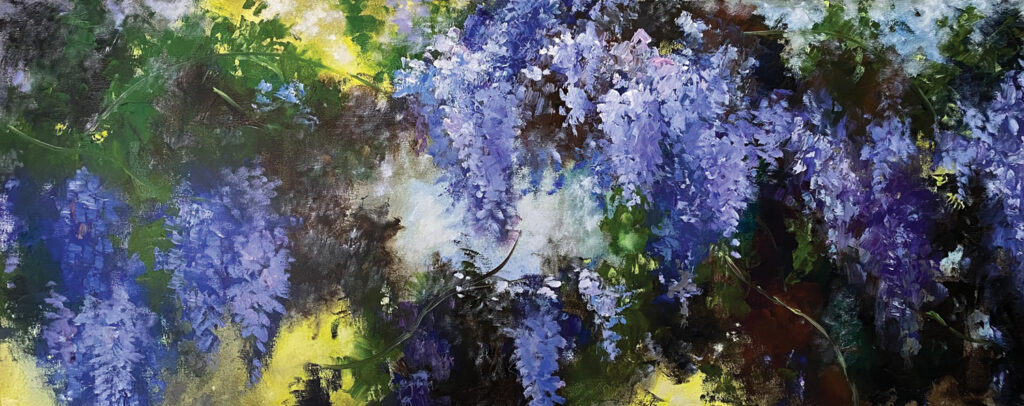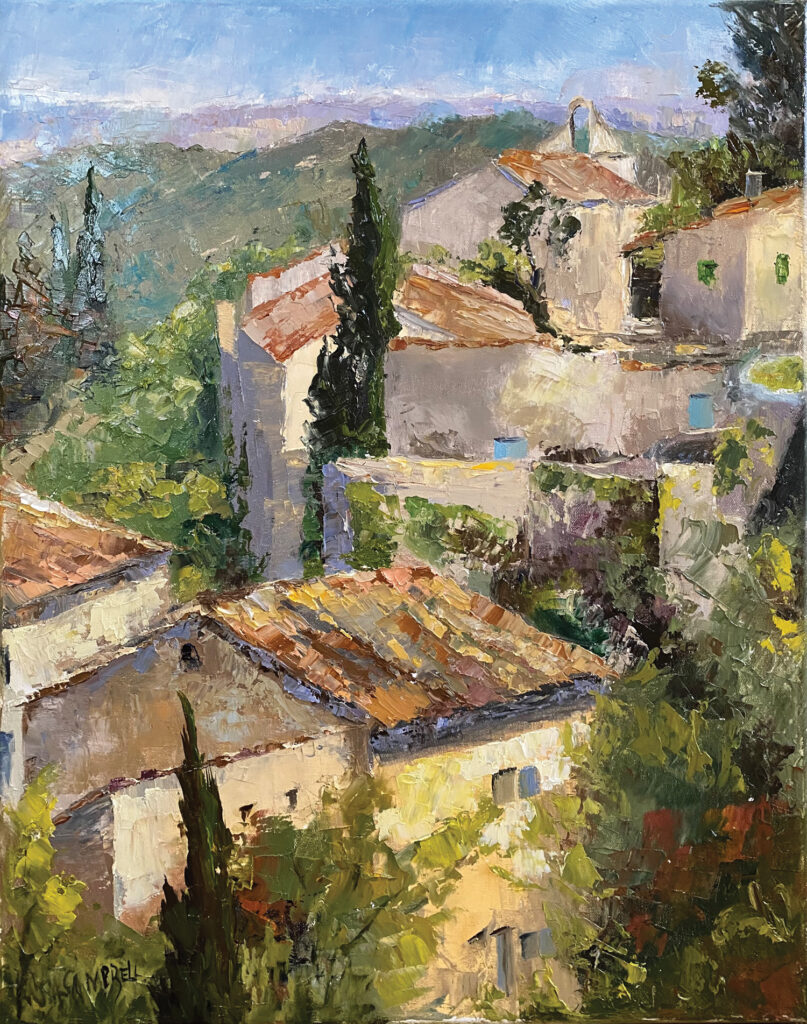L’art C’est La Vie
Art seeps into every part of a Wilmington painter’s life
BY Christine Russell Gonzalez

Art is more than what Katia Campbell does. It is the hub of family discussion. It is cherished, and an investment of time and energy. In regard to her family, she says it is “our life.”
Campbell, a native of France, enjoys the challenge of painting alla prima, typically with oils and palette knives. She is part of a group of five painters who meet regularly in places like Wade Park, the beach, Hewlett’s Creek, Greenfield Lake, the Intracoastal Waterway, or someone’s colorful backyard.
She makes the plein air sessions memorable, arriving in her pickup truck with her constant companion, Charlie, a bilingual French pug. Along with her painting supplies, she often brings a faux-silver pitcher filled with tea made from herbs freshly picked from her garden to share with her aesthete companions.

“I love being outdoors. I like to go to a beautiful spot and paint the scene that I see in one sitting. You have to be very quick because the light is moving constantly, and it’s cold or it’s hot. I love that challenge,” Campbell says.
Many of her family and friends are also artists. Her great aunt was a well-known portraitist and has a municipal museum named after her, Musée Elise Rieuf located in Massiac, in the Auvergne region of central France.
“She was a fabulous portraitist who lived for a few years in Shanghai and brought back to Paris portraits and landscapes of China, very unusual in the ‘20s. We were close. I lived in a family in France where art was central to everyone’s life. My mother, her siblings, certainly my aunt, all of us, whenever we get together that’s what we talk about,” she says.
Rieuf’s maître was Marguerite Jeanne Carpentier (1886-1965), an award-winning sculptor and painter who worked with Rodin. Campbell’s family have taken on the quest to collect and restore the works of Carpentier, an artist now recognized for her worth who has a few pieces at the prestigious Orsay Museum in Paris.
“When we gather, my family will talk about this new painting we’ve just discovered or that other we’re restoring and so on,” Campbell says. “My aunt Sophie has devoted her life to gathering and protecting the work of Carpentier and making it known to the world. It is an amazing corpus of paintings and sculptures.”
Campbell admires the pioneering dedication of female painters. It’s one of the themes of the museum in Massiac. A visitor described it as a place to learn about the condition of women artists during the Roaring ‘20s.
Carpentier found abundant inspiration in history and legends, Greek and Roman mythology, and scenes from the streets in Paris. She won a prestigious Paris sculpting award in 1924 for Le Gamin de Paris.
Campbell’s paintings reflect a life of travel, including village vistas from France and familiar scenes from Wilmington. Her work mixes an interesting dab of realism with impressionism, making things vibrant and full of life. The subjects are more in focus than traditional impressionism.





Her botanical studies of flowers and fruits on the vine are richly painted. In her Cherries and Prunes Blues, the fruit is nearly too beautiful to eat.
There is a dreamy quality to Campbell’s work. Wade Park looks like a private oasis instead of a suburban pond in the heart of Wilmington. The peachy orange colors of the sails on the fishing boat in Le Sinagot make a delightful contrast to the aqua waters of Brittany.
The still life and portraiture works created in her studio employ more classical techniques. She broadens her color palette, uses brushes, and attempts to capture the likeness of her subject.
Her use of color to enhance reality can be seen in a photo of Soupe au Chou in progress. The painted colors are deeper and richer than the actual models. The veins on the cabbage stand out a bit more than you can see with the eye, and the peach tone added on the squash makes it more enticing.
Van Gogh is one of the artists Campbell particularly admires. She can get lost in his white and light green flowers in Still Life: Vase with Roses, Saint-Remy, May 1890, currently in the Washington National Gallery.



“I find there is such a deep-seated parallel between his intimate writings to his brother and this energy you read in his paintings. Few painters have managed to translate that pure naked energy, this suffering we know he went through. And then to translate that into such poignant beauty, that’s fabulous,” she says.
While not as thick as Van Gogh’s impasto style, Campbell is finding she prefers palette knives to brushes.
“You can make thick, bold textures and scrapings with the knife. And the richly pigmented viscosity of oil paint is most satisfying to me. Unlike watercolor, it’s a matter you can sculpt, and I am attracted to that,” she states.
She aims for accuracy in laying down paint, placing colors in a well-conceived spot while avoiding overmixing.
“I don’t go back and retouch, not unless absolutely necessary,” she says. “In other words, the nuance is made by putting slightly different colors side by side until I get the shape of what I’m trying to depict. I will put in juxtaposition a fan of nuanced colors that will then translate shape.”
Campbell points out why Wilmington is a draw for landscape artists.
“What is lovely in Wilmington is that we have water everywhere,” she says. “It’s a little bit like Amsterdam or Venice. Wherever you turn you have water, be it the river, or the intracoastal, or the ocean. It’s a gracious landscape. That’s why so many people are attracted to Wilmington, certainly people who have an artistic soul.”
The favorable temperatures and lush vegetation make the Wilmington area a hotspot for painters as well.
“In the spring the town is taken hostage by the blue splendor of wisteria, drapes of lavender and purple everywhere. It’s a balmy enchantment that turns drabness into blue opulence,” she says.
Campbell’s work can be viewed at Paysage Home in Lumina Station in Wilmington and in Chapel Hill. (Paysage means landscape in French).
Contact Campbell by email at Campbellkatia7@gmail.com to view her work by appointment. She is also available for commission work.


